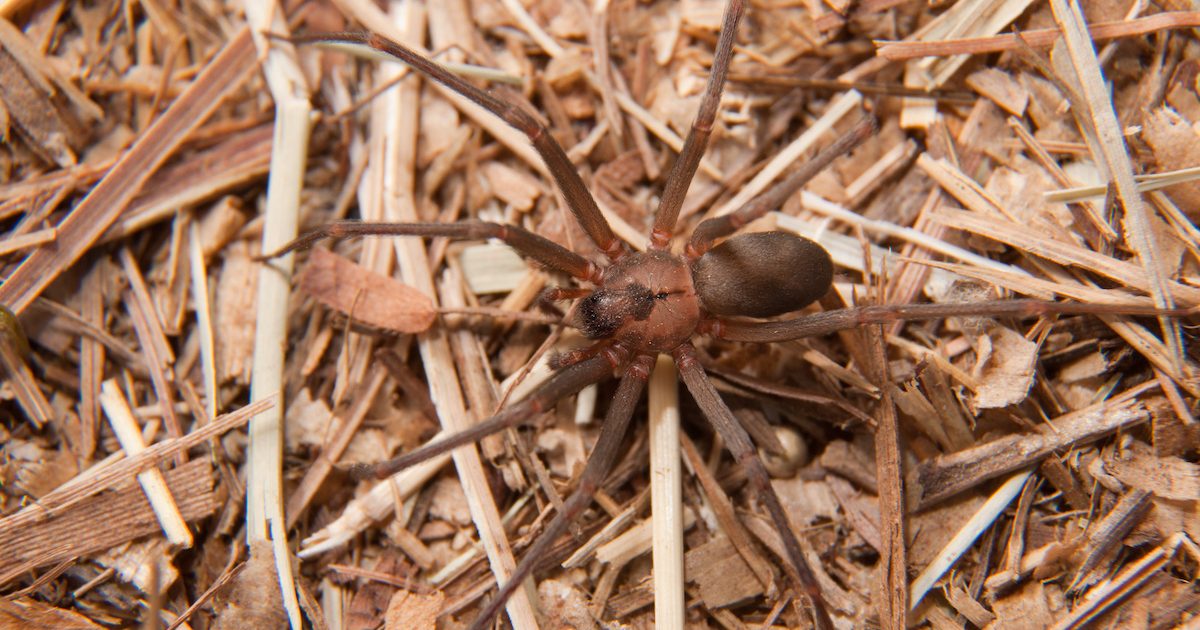
It’s brown recluse spider season. That’s the spider with the violin markings on its back – sometimes called the fiddle back spider, brown fiddler, or violin spider. Brown recluse spiders are rather shy and non-aggressive, but they have a powerful poison. Occasional bites happen because people and brown recluses often share the same living space.
From a research team at Kansas State University’s Department of Entomology, here are 10 things to know about these venomous spiders that like to live where we do:
1. Brown recluse spiders are found outdoors in the U.S. Midwest, as well as inside structures
They tend to thrive in the same environments that humans do.
2. Brown recluse spiders are venomous
But bites do not always result in large, necrotic lesions where surrounding tissue dies. Often, the bite goes unnoticed and only results in a pimple-like swelling. However, some people develop a necrotic wound (with blood and pus) which is slow to heal, with the potential for a secondary infection.
3. They readily feed on prey that is dead
So, they are attracted to recently killed insects. However, they can and will also attack live prey.
4. Brown recluses build small, irregular webs
They can usually be found in out-of-the-way places, but they do not use these to capture prey. They tend to hide in the dark and move around at night searching for prey.
5. It can take 1-2 years to reach adulthood
A brown recluse is tiny when it first emerges from the egg case and takes several molts to reach adulthood, six to 12 months. Remember, they are only active from March to October so this may take one to two years. Then they may live two to three years as adults.
6. Sticky traps for spiders and other insects, available at most hardware and garden stores, work well to trap brown recluse spiders
They may not significantly reduce the numbers, but definitely help, and are a great way to detect and monitor the spider populations.
7. Brown recluse spiders are mostly only active from March through October
Trying to control them from October through March is generally not necessary or useful.
Insecticides labeled to control brown recluse spiders kill the spiders but must be sprayed directly on them, or the spider needs to come into direct contact with the treated area while it is still damp. Otherwise, little control is achieved.
8. Females create egg sacs
Female brown recluse spiders deposit 40-50 eggs in a silken egg sac, which is off-white, with the outer covering loosely woven. Each sac contains between 31-300 eggs. The eggs hatch in 25-39 days and the spiderlings undergo at least one molt within the sac before emerging. The development period (egg to adult) averages 336 days.
The female spins an irregular web in undisturbed areas, like the garage, attic, and basement. The web is not used to catch prey, but rather as a retreat. Outside, brown recluse spiders are typically found around rocks, piles of inner tubes, utility boxes, woodpiles, under bark, etc. These spiders have been found in such places as cedar shake roofs.
9. Brown recluse spiders are better controlled with insecticides on non-carpeted surfaces
Preventative measures like sealing cracks in foundations and walls, clearing clutter in and around the home, moving woodpiles away from the house, placing sticky traps in low traffic areas and spraying pesticides can help eliminate brown recluse populations within the home.
10. They are drawn to paper products
They are most commonly found in boxes, among papers, and in seldom-used clothing and shoes, although they can be found in corners, underneath tables and chairs, or in crevices such as those found along baseboards, doors, and window moldings. Storage areas such as closets, bedrooms, attics, crawl spaces, and basements are the preferred nesting areas of brown recluse spiders.
More About Brown Recluse Spiders
With respect to food, brown recluse spiders prefer to live with small prey, such as cockroaches and crickets. If their prey is large, they would rather it is dead, presumably to avoid damage to themselves. Their prey is primarily insects. Brown recluse spiders often live outdoors where they are typically found around rocks, utility boxes, and woodpiles.
Brown recluses also referred to as violin spiders, have a dark brown violin-shaped marking on the cephalothorax, which is the portion of the body to which the legs attach. However, to accurately identify a recluse, you need to look at the eye pattern, six eyes in pairs with a space separating the pairs.
They use their fangs to inject deadly venom into their prey to subdue them. Like most spiders, the brown recluse can survive months without food or water. Despite the media hype and public hysteria surrounding brown recluse spiders, their bites are not life-threatening. These withdrawn and timid spiders prefer to spend daylight hours in retreat.
If you see any of these spiders in your home, contact DriveBye Exterminators and a professional can help you today!






